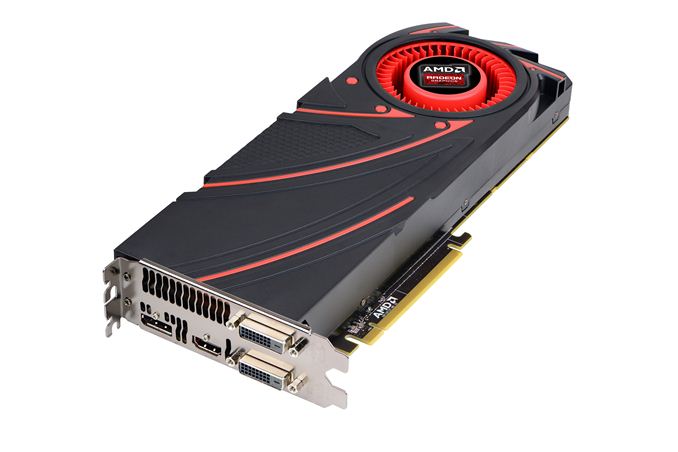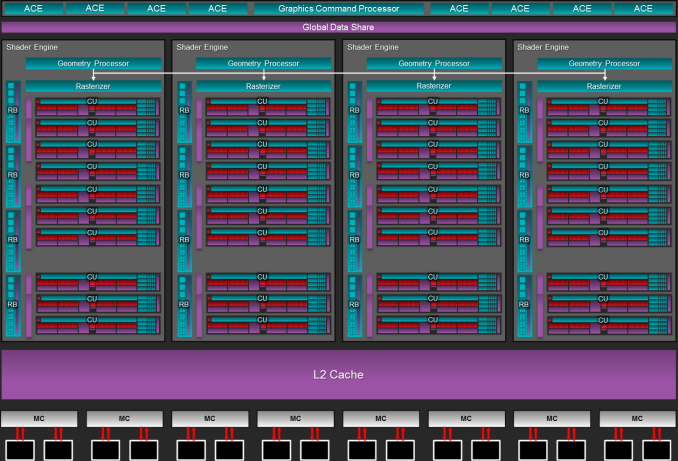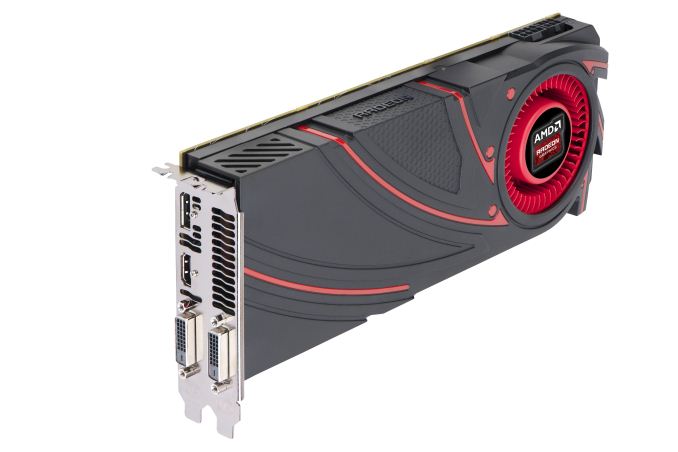The AMD Radeon R9 290 Review
by Ryan Smith on November 5, 2013 12:01 AM EST- Posted in
- GPUs
- AMD
- Radeon
- Hawaii
- Radeon 200

With the launch of AMD’s Radeon R9 290X less than 2 weeks ago, the video card marketplace has become very active very quickly. The 290X not only reasserted AMD’s right to fight for the video card performance crown, but in doing so it has triggered an avalanche of pricing and positioning changes that have affected both NVIDIA and AMD.
NVIDIA for their part cut the price of the GTX 780 and GTX 770 to $500 and $330 respectively, repositioning the cards and giving them their first official price cuts since their spring launches. Meanwhile AMD has also made some changes, and although 290X is unaffected for the moment, 290 was affected before it even launched, receiving an arguably significant specification adjustment. Consequently with GTX 780’s price cut being NVIDIA’s counter to 290X, 290 has gone from just being a lower tier Hawaii card to also being AMD’s counter-counter, and in the process has become a somewhat different card than what it was going to be just one week ago.
But before we get ahead of ourselves, let’s start at the beginning. With the successful launch of the 290X behind them, and the equally successful launch of their new flagship GPU Hawaii, AMD is ready to make their next move. Launching today will be the Radeon R9 290, the obligatory lower-tier part for AMD’s new flagship lineup. Making the usual tradeoffs for a lower-tier part, AMD is cutting down on both the number of functional units and the clockspeeds, the typical methods for die harvesting, in exchange for a lower price. Now officially AMD has not announced the Radeon R9 290 in advance, but with listings for it having already gone up on the same day as the 290X, it’s something that everyone has been expecting.
As always we’ll offer a full breakdown of performance and other attributes in the following pages, but before we even begin with that we want to point out that the 290 is going to be one of AMD’s most controversial and/or hotly debated launches in at least a couple of years. The merits of 290X were already hotly debated in some gaming circles for its noise relative to its performance and competition, and unfortunately 290 is going to be significantly worse in that respect. We’ll have a full rundown in the following pages, but in a nutshell AMD has thrown caution into the wind in the name of maximizing performance.
| AMD GPU Specification Comparison | ||||||
| AMD Radeon R9 290X | AMD Radeon R9 290 | AMD Radeon R9 280X | AMD Radeon HD 7970 | |||
| Stream Processors | 2816 | 2560 | 2048 | 2048 | ||
| Texture Units | 176 | 160 | 128 | 128 | ||
| ROPs | 64 | 64 | 32 | 32 | ||
| Core Clock | 727MHz | 662MHz | 850MHz | 925MHz | ||
| Boost Clock | 1000MHz | 947MHz | 1000MHz | N/A | ||
| Memory Clock | 5GHz GDDR5 | 5GHz GDDR5 | 6GHz GDDR5 | 5.5GHz GDDR5 | ||
| Memory Bus Width | 512-bit | 512-bit | 384-bit | 384-bit | ||
| VRAM | 4GB | 4GB | 3GB | 3GB | ||
| FP64 | 1/8 | 1/8 | 1/4 | 1/4 | ||
| TrueAudio | Y | Y | N | N | ||
| Transistor Count | 6.2B | 6.2B | 4.31B | 4.31B | ||
| Typical Board Power | ~300W (Unofficial) | ~300W (Unofficial) | 250W | 250W | ||
| Manufacturing Process | TSMC 28nm | TSMC 28nm | TSMC 28nm | TSMC 28nm | ||
| Architecture | GCN 1.1 | GCN 1.1 | GCN 1.0 | GCN 1.0 | ||
| GPU | Hawaii | Hawaii | Tahiti | Tahiti | ||
| Launch Date | 10/24/13 | 11/05/13 | 10/11/13 | 12/28/11 | ||
| Launch Price | $549 | $399 | $299 | $549 | ||
Diving right into the hardware specifications, Radeon R9 290 is a bit more powerful than usual for a lower-tier part. AMD has cut the number of CUs from 44 to 40 – disabling 1 CU per SE – while adjusting down the base GPU clockspeed and boost GPU clockspeed to from 727MHz and 1000MHz to 662MHz and 947MHz respectively. However AMD has not cut the amount of memory, the memory clockspeed, the memory bus width, or the number of ROPs, leaving those at 5GHz for the memory clockspeed, 512-bits for the memory bus width, and all 64 ROPs for the back-end hardware.
As a result the differences between the 290 and 290X are on paper limited entirely to the clockspeed differences and the reduced number of CUs. At their top boost bins this gives 290 95% the clockspeed of 290X, and 91% of the shader hardware, giving 290 100% of 290X’s memory performance, 95% of 290X’s ROP and geometry performance, and 86% of 290X’s shading/texturing performance.
Compared to AMD’s last generation offerings, the 290 is going to be closer to 290X than 7950 was to 7970. 290 retains a larger percentage of 290X’s shader and ROP performance, never mind the fact that the full 320GB/sec of memory bandwidth is being retained. As such despite the wider price difference this time around, performance on paper is going to be notably closer. Paper will of course be the key word here, as in the case of 290 more so than any other card we’ve looked at in recent history theory and practice will not line up. Compared to the 290X, practice will be favoring the 290 by far.
Moving on to power consumption, perhaps because of AMD’s more aggressive specifications for their lower-tier card this time around, power consumption is not dropping at all. AMD is still not throwing us any useful hard numbers, but based on our performance data we estimate the 290 to have a nearly identical TDP to the 290X, leading us to keep it at an unofficial 300W. Lower-tier parts typically trade performance for power consumption, but that will not be the case here. Power consumption will be identical while performance will be down, so efficiency will be slipping and 290 will have all the same power/cooling requirements as 290X.
Meanwhile like the 290X launch, the 290 launch is going to be a hard launch, and a full reference launch at that. As such we’ll be seeing 290 cards go up for sale at the usual retailers today, with all of those cards using AMD’s reference cooler and reference board, itself unchanged from the 290X.
As for pricing and competitive positioning, AMD will be launching the 290 at what we consider to be a very aggressive price of $399. Based on the initial specifications, the performance, and the competition, we had been expecting AMD to launch this at $449, mirroring the launch of the 7950 in the process. But AMD has gone one step further by significantly undercutting both themselves and NVIDIA.
290’s immediate competition on the AMD side will be the $549 290X above it and the $299 280X below it, while on the NVIDIA side the competition will be the $499 GTX 780 above it and the $329 GTX 770 below it. Pricing wise this puts 290 as closer competition to 280X/GTX 770 than it does the high-tier cards, but as we’ll see in our benchmarks AMD is aiming for the top with regards to performance, which will make price/performance comparisons both interesting and frustrating at the same time.
NVIDIA for their part will have their 3 game Holiday GeForce Bundle on the GTX 780 and GTX 770, presenting the same wildcard factor for overall value that we saw with the 290X launch. As always, the value of bundles are ultimately up to the buyer, especially in this case since we’re looking at a rather significant $100 price gap between the 290 and the GTX 780.
| Fall 2013 GPU Pricing Comparison | |||||
| AMD | Price | NVIDIA | |||
| Radeon R9 290X | $550 | ||||
| $500 | GeForce GTX 780 | ||||
| Radeon R9 290 | $400 | ||||
| $330 | GeForce GTX 770 | ||||
| Radeon R9 280X | $300 | ||||
| $250 | GeForce GTX 760 | ||||
| Radeon R9 270X | $200 | ||||
| $180 | GeForce GTX 660 | ||||
| $150 | GeForce GTX 650 Ti Boost | ||||
| Radeon R7 260X | $140 | ||||












295 Comments
View All Comments
HisDivineOrder - Tuesday, November 5, 2013 - link
Haha, spoken like someone who's never heard a card this loud. I can't wait to see all these cards on sale on ebay and forums everywhere. "I tried it and it's not for me, sidegrading to a 780," they'll say.This card is so loud you're going to be shocked by it. It's going to blow people's minds and it may even convert a few fanboys.
Finally - Tuesday, November 5, 2013 - link
If he buys one with a nice custom fan, there won't be anything left to complain about. Truly terrible outlook for an Nvidiot, isn't it?TheJian - Tuesday, November 5, 2013 - link
You're forgetting they are using ref NV also. You don't get that when you buy an NV card and they come overclocked on top of quiet. Also this thing will draw the same watts no matter what. It remains to be seen how good a different cooler will actually be. Did AMD really choose two terrible fans for their product launch? Seriously? I'm wondering how much they can really fix this situation. AMD had to know this would cause bad reviews about noise nearly everywhere and even on AMD loving sites. I can't believe they are completely dumb, and chose a total piece of junk for the fan/heatsink here. I really think people are putting to much faith in a fix with a fan change. They are at 95 all day basically, how much fan do you need to fix that?If NV runs their gpus at 95 tomorrow (and cranked up even more to meet the noise they're getting here) these cards will both be spanked. You get a better cooler on NV cards that are NOT ref also.
jnad32 - Tuesday, November 5, 2013 - link
The way I look at it, AMD is looking like an absolute genius. Everyone was ripping them on the 290X for it being too hot and too loud anyway. So instead of keeping the sound levels down they just went for what they do best, price/performance. They are now blowing every other card out of the water. There isn't a card on the planet that can touch this card in price/performance. Yea its loud as hell but, at least you have to think about it now just because of the price. What I really want to see is them unleash the 290X sound threshold and see what kind of raw numbers it can put up. Lets be honest, the only people who should buy reference cards are the ones who are putting water blocks on them.People have been saying this about the temp since launch, and I still don't get it. If AMD designed the chip to run at those temps, what's the big deal as long as it's not damaging it.
swing848 - Tuesday, November 5, 2013 - link
It will only get loud for me when playing games or the occasional benchmark. During games I wear headphones, and during benchmarks I can leave the room. I have a room dedicated to computer use and the house has good sound proofing, so, it will not bother other people.If I want it quiet I will use a water cooler with a large radiator and fan.
It is better than dumping all the hot air from the video card into my case, even if it is well cooled with 200mm fans. I overclock my CPU and I do not want it, RAM, or chips on the motherboard to get any hotter than necessary.
zeock9 - Tuesday, November 5, 2013 - link
The burning question on my mind at this point is why AMD is restricting board partners from releasing their own custom designed and obviously better performing coolers on this otherwise fantastic card?techkitsune - Tuesday, November 5, 2013 - link
They likely don't want to look bad.It's okay. It's tough doing thermal management. I cram 1,000w of LED into a 30mm x 30mm space. AMD doesn't have the cooling problems that I have. Nor does nVidia nor intel. They should be grateful. :D
HisDivineOrder - Tuesday, November 5, 2013 - link
They don't have them yet. That's why they haven't made custom boards. They're just getting them right now. They're going with what they have, which right now are just the reference boards. In a month or so, they'll have QA'ed some solutions with pre-existing cooling options, assuming said cooling options are good enough to benefit these cards.The thing is, you have to know these cards are running REALLY, REALLY hot to hit these levels at 95 degrees, so... custom coolers may have a hard time handling these cards without some tweaks. Perhaps to get faster fans on there.
Also, it takes time to redesign a board to add VRM's and the 290 and 290X are still very, very new. You're not going to get an MSI Lightning version overnight.
It's a solid deal in price, but man it's a shame AMD didn't offer a better custom cooler more attuned to the very special needs of the 290 series. It's also a shame their board is being pushed so hard and so much above what it seems capable of doing with reasonable power levels.
This is like the Bulldozer of GPU's.
techkitsune - Tuesday, November 5, 2013 - link
AMD could have just spent a few more dollars and used copper instead of aluminum, I would think. They could have easily doubled or tripled thermal conductivity and thus not needed to run the reference cooler anywhere near as high, plus that would leave a LOT of extra overclocking room.I still would buy it for the extra $45 that would have likely entailed, though I do worry about weight at that point. My 9800 GTX+ was pretty hefty, to say the least.
TheinsanegamerN - Tuesday, November 5, 2013 - link
THIS. why does amd, or heck, any manufacturer, insist on using aluminum fins on a 250 watt+ gpu? my old amd 2600xt had a full copper heatsink, and it was nowhere near as power hungry as this card (and it ran cool to boot. never over 47c).use the exact same heatsink, but make those fins copper. wonder how much lower the temps would go?